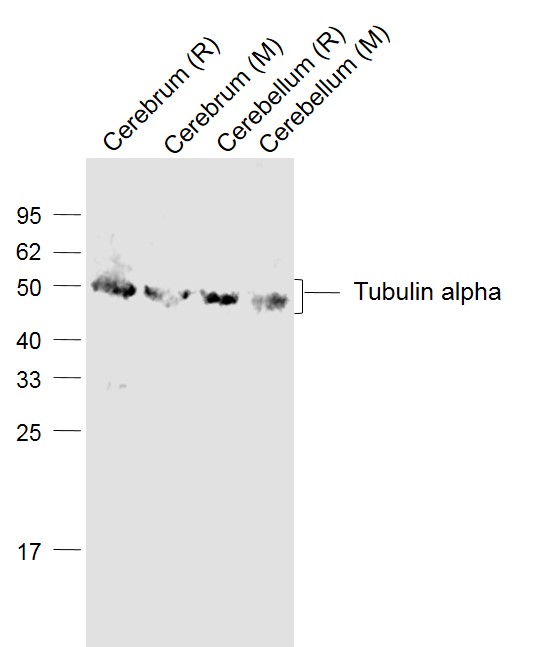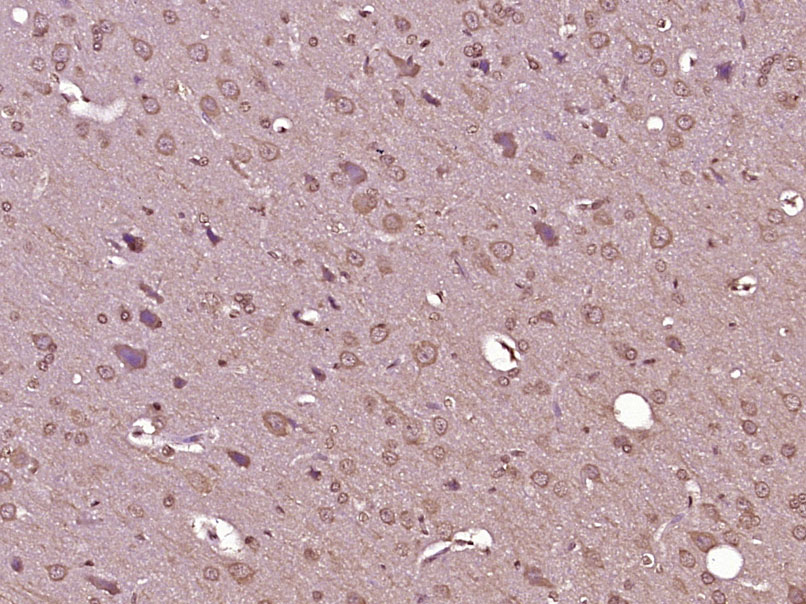
Details
Product Name Tubulin alpha (Loading Control) Chinese Name 微管蛋白α 1A/1B(内参)抗体 Alias TUBA1A + TUBA1B; Tubulin, Alpha 1b; Tubulin Alpha-Ubiquitous Chain; Alpha-Tubulin Ubiquitous; Tubulin K-Alpha-1; Tubulin, Alpha, Ubiquitous; Tubulin Alpha-1B Chain; Alpha Tubulin; Tubulin-alpha; Ubiquitous; K-ALPHA-1; Tubulin Alpha; TBA1B_HUMAN; Tubulin, Alpha 1a; TUBA3; Tubulin Alpha-3 Chain; Tubulin B-Alpha-1; LIS3; Tubulin, Alpha, Brain-Specific; Tubulin Alpha-1A Chain; Alpha-Tubulin 3, Brain-Specific; Hum-A-Tub1; Hum-A-Tub2; B-ALPHA-1; TBA1A_HUMAN; 微管蛋白alpha Product Type Internal reference anti Research Area Cell biology immunology Cytoskeleton Immunogen Species Rabbit Clonality Polyclonal React Species Human, Mouse, Rat, (predicted: Chicken, Pig, Cow, ) Applications WB=1:500-2000 ELISA=1:5000-10000 IHC-P=1:100-500 IHC-F=1:100-500 ICC=1:100 IF=1:100-500 (Paraffin sections need antigen repair)
not yet tested in other applications.
optimal dilutions/concentrations should be determined by the end user.Theoretical molecular weight 50kDa Cellular localization cytoplasmic Form Liquid Concentration 1mg/ml immunogen KLH conjugated synthetic peptide derived from human TUBA1A + TUBA1B: 401-451/451 Lsotype IgG Purification affinity purified by Protein A Buffer Solution Preservative: 15mM Sodium Azide, Constituents: 1% BSA, 0.01M PBS, pH 7.4 Storage Shipped at 4℃. Store at -20 °C for one year. Avoid repeated freeze/thaw cycles. Attention This product as supplied is intended for research use only, not for use in human, therapeutic or diagnostic applications. PubMed PubMed Product Detail Microtubules of the eukaryotic cytoskeleton perform essential and diverse functions and are composed of a heterodimer of alpha and beta tubulins. The genes encoding these microtubule constituents belong to the tubulin superfamily, which is composed of six distinct families. Genes from the alpha, beta and gamma tubulin families are found in all eukaryotes. The alpha and beta tubulins represent the major components of microtubules, while gamma tubulin plays a critical role in the nucleation of microtubule assembly. There are multiple alpha and beta tubulin genes, which are highly conserved among species. This gene encodes alpha tubulin and is highly similar to the mouse and rat Tuba1 genes. Northern blotting studies have shown that the gene expression is predominantly found in morphologically differentiated neurologic cells. This gene is one of three alpha-tubulin genes in a cluster on chromosome 12q. Mutations in this gene cause lissencephaly type 3 (LIS3) - a neurological condition characterized by microcephaly, mental retardation, and early-onset epilepsy and caused by defective neuronal migration. Alternative splicing results in multiple transcript variants encoding distinct isoforms. [provided by RefSeq, Jul 2012]
Function:
Tubulin is the major constituent of microtubules. It binds two moles of GTP, one at an exchangeable site on the beta chain and one at a non-exchangeable site on the alpha chain
Subunit:
Dimer of alpha and beta chains. A typical microtubule is a hollow water-filled tube with an outer diameter of 25 nm and an inner diameter of 15 nM. Alpha-beta heterodimers associate head-to-tail to form protofilaments running lengthwise along the microtubule wall with the beta-tubulin subunit facing the microtubule plus end conferring a structural polarity. Microtubules usually have 13 protofilaments but different protofilament numbers can be found in some organisms and specialized cells.
Subcellular Location:
Cytoplasm, cytoskeleton.
Tissue Specificity:
Ubiquitously expressed with highest levels in Brain, Bone, Adipocyte, and Breast
Post-translational modifications:
Undergoes a tyrosination/detyrosination cycle, the cyclic removal and re-addition of a C-terminal tyrosine residue by the enzymes tubulin tyrosine carboxypeptidase (TTCP) and tubulin tyrosine ligase (TTL), respectively.
Some glutamate residues at the C-terminus are polyglutamylated. This modification occurs exclusively on glutamate residues and results in polyglutamate chains on the gamma-carboxyl group. Also monoglycylated but not polyglycylated due to the absence of functional TTLL10 in human. Monoglycylation is mainly limited to tubulin incorporated into axonemes (cilia and flagella) whereas glutamylation is prevalent in neuronal cells, centrioles, axonemes, and the mitotic spindle. Both modifications can coexist on the same protein on adjacent residues, and lowering glycylation levels increases polyglutamylation, and reciprocally. The precise function of such modifications is still unclear but they regulate the assembly and dynamics of axonemal microtubules (Probable).
Acetylation of alpha chains at Lys-40 stabilizes microtubules and affects affinity and processivity of microtubule motors. This modification has a role in multiple cellular functions, ranging from cell motility, cell cycle progression or cell differentiation to intracellular trafficking and signaling (By similarity).
Similarity:
Belongs to the tubulin family.
SWISS:
Q71U36
Gene ID:
7846
Database links:TUBA1A:
Entrez Gene: 7846 Human
Entrez Gene: 22142 Mouse
Omim: 602529 Human
SwissProt: Q71U36 Human
SwissProt: P68369 Mouse
Unigene: 654422 Human
Unigene: 405359 Mouse
Unigene: 234326 Rat
TUBA1B:
Entrez Gene: 10376 Human
Entrez Gene: 22143 Mouse
Omim: 602530 Human
SwissProt: P68363 Human
SwissProt: P05213 Mouse
Unigene: 524390 Human
Unigene: 392113 Mouse
Unigene: 99661 Rat
Product Picture
Lane 1: Cerebrum (Rat) Lysate at 40 ug
Lane 2: Cerebrum (Mouse) Lysate at 40 ug
Lane 3: Cerebellum (Rat) Lysate at 40 ug
Lane 4: Cerebellum (Mouse) Lysate at 40 ug
Primary: Anti-Tubulin alpha (SL20496R) at 1/1000 dilution
Secondary: IRDye800CW Goat Anti-Rabbit IgG at 1/20000 dilution
Predicted band size: 50 kD
Observed band size: 50 kD
Paraformaldehyde-fixed, paraffin embedded (Rat brain); Antigen retrieval by boiling in sodium citrate buffer (pH6.0) for 15min; Block endogenous peroxidase by 3% hydrogen peroxide for 20 minutes; Blocking buffer (normal goat serum) at 37°C for 30min; Antibody incubation with (Tubulin alpha) Polyclonal Antibody, Unconjugated (SL20496R) at 1:400 overnight at 4°C, followed by operating according to SP Kit(Rabbit) (sp-0023) instructionsand DAB staining.
Bought notes(bought amounts latest0)
User Comment(Total0User Comment Num)
- No comment




 +86 571 56623320
+86 571 56623320
 +86 18668110335
+86 18668110335

